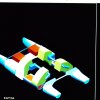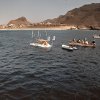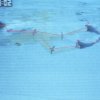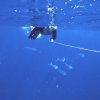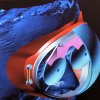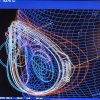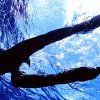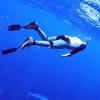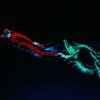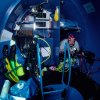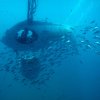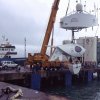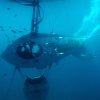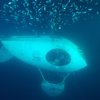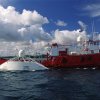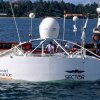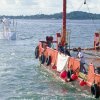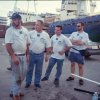OCEAN ADVENTURES
_________________________________________________________________________________________________________________
"My relationship to water is truly carnal."
- Born in the depths of the Champagne countryside, nothing predisposed Guy Delage to love ocean immersions ... It’s one of them that will make him becoming famous !
- Endurance swimmer, very early, he discreetly performs several difficult long distances crossings.
- At 18 years, he swam across the Channel, alone and without any assistance.
- In 1973 he swam from town Le Conquet to the island Ouessant, still alone and without any assistance.
- Since the age of 15, he spends thousands of hours on diving and snorkeling.
- « Opération Océanantes » : On 16 December 1994, Guy Delage left the beaches of Cabo Verde (Mindelo Island) alone, crossed the Atlantic, drifting and swimming, and arrived on 9 February 1995 on the Island of Barbados.
- « Mission Oxygène » : In 1998, he tried to cross the Indian Ocean by drifting in an underwater submarine bell, Ocean Observer, at 7 meters depth.
- Since 2002 and until 2016, he has carried out numerous explorations in diving and snorkeling in contact with large marine mammals and sharks in places that are still fairly well preserved in the Caribbean and the Pacific Ocean (Los Roques and Los Aves -Venezuela- , Light house reef and Glover reef - Belize -, Silver bench and Bank of the Handkerchief -Turks and Caicos and Dominican Republic, Las Perlas -Panama-, Malpelo-Colombia, Galapagos -Equator-, Henderson -Pitcairn Islands-, Gambiers, Tuamotous, Marquesas-French Polynesia-)
1994 : "OCEANANTES", ATLANTIC SWIMMING AND DRIFTING

On December 16th, 1994, Guy Delage leaves alone the beaches of the archipelago of Cabo Verde.
The goal is to reach the Caribbean island of Barbados, swimming 6 to 8 hours a day (25 to 30 km with fins) and drifting the rest of the time on a tiny raft. There are no accompanying boats. He arrived in Barbados 55 days later!
Characteristics of the raft :
Main Sponsors :
- Sector Watches
- Nantes Town Hall
- Generale of Restoration
- Nestlé Research Center
- Leclerc Verdun
Objectives :
- Studying human behavior during long-term efforts in hostile environments (physiology, psychology, stress)
- Observe the pelagic fauna encountered and its behavior
- Develop a set of products (feed, mask, fins, combination, anti electric shark).
Hardware :
- Raft: 2m long by 0.6m wide and 0.75m high. Equipment 110 kg. Food 153 kg
- Swimming Float
- Prototype flippers, prototype mask, prototype swimming suit.
Preparation :
- 900 hours of endurance training (coach Laurent Schmidt)
- Nutritional preparation
- 150 scientists from 55 research programs to produce the materials needed for the operation.
Encountered difficulties :
- Shark attack
- Loss of the raft for 2 hours 30
- Burning of jellyfish physalia causing anaphylactic shock
Results, advances in knowledge, patents :
- Panoramic vision mask (170 °) without deformation (now used by the US Navy)
- Endurance fins
- Diving and swiming suit for long-term effort
- Dietary Supplement adapted to the nutrition of diabetics (Nestlé)
- Electric Shark System (sharkpod)
Scientific publications :
- Observations Ichthyology - Cybium 1995, 19 (4): 413-417
- Amac 9th Composites Days 22-24 Nov 1994
- Mechanism of damage of composites (Lamy-Burtin) 11th French congress of mechanics Lille 1993
- The combination of the exploit - ITF - 1995
Press releases
- 5500 magazine and press publications worldwide
- 29 hours of television on channels from around the world
- 47 hours of French-language radio and 8 hours on radios from non-French speaking countries!
1998 : "OXYGEN MISSION"

Crossing the Indian Ocean in 1998 in a submarine drifting habitat at -7m.
Difficult experience that opened up knowledge of the oceans in general and of the pelagic world in particular. Ocean Observer was to be an alert operation in direction of the general public."Pollution, fishing pressure, climatic desease are all phenomena that destroy the ocean balance. The future of man is played out in the depths of bluewaters because phyto plankton produces 80% of our oxygen, and more and more consciences are rising against the abuses of our industrial society to do that this environment must remain intact ... "
Main Sponsors :
- Sector Watches
- Jouvance Laboratories
Objectives :
Verification of the physiological capacity of man to resist in shallow blood nitrogen saturation with successive ascents to surface atmospheric pressure.
- Observation of the stress mechanisms of such a test. - Observation and report of the pelagic life by favoring its concentration around a drifting object.
- Collection of phytoplankton and zooplankton samples to develop a qualitative inventory of the area.
Aerial material = Steel float (Rougerie design)
- Length 10m
- Width 4.5 m
- Weight 12 tons
- Lest: 12.5 tons.
- Regeneration and compression of the air: 2 electric compressors 40l / min, 1 thermal compressor 26m3 / h, regeneration system with lithium hydroxide.
- Energy: 4 wind turbines, 12 * 85 W solar panels, batteries 1000 A / h in 12 V.
Underwater Material
= Steel Habitat (Rougerie Design)
- Long 6m
- Width 2.2m
- Volume 16 m3
- Weight 6.5 tons
- Facilities : 1 office, 1 WC, 1 berth, 2 microwaves
Communication systems :
Immarsat B, C, B.LU and V.H.F.
Preparation :
- simulation at the hyperbaric center of Ravenna in Italy
- Test in situ in the port of Havre.
Difficulties encountered :
- Abnormally strong weather conditions for the season (El Nino?)
- Breakage of the under - marine habitat suspension (resistance 200 tons), and sinking of the submarine habitat after 13 days of drift.
Results, advances in knowledge :
- Observations in marine biology carried out at 65%
- Planktonic samplings carried out at 60%
- Experience ( Sinking of Ocean Observer) leading to the design of new submarine habitats.




